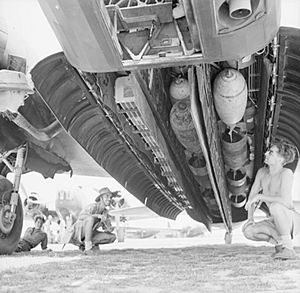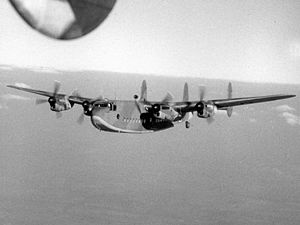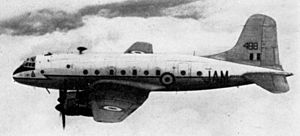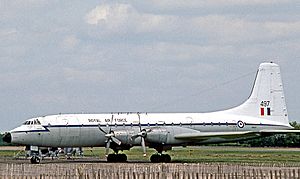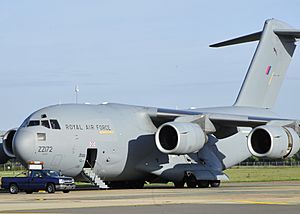No. 99 Squadron RAF facts for kids
Quick facts for kids No. 99 Squadron RAF |
|
|---|---|
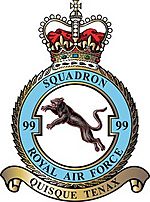
Squadron badge
|
|
| Active | 15 August 1917 – 1 April 1918 (RFC) 1 April 1918 – 1 April 1920 (RAF) 1 April 1924 – 15 November 1945 17 November 1945 – 6 January 1976 November 2000 – present |
| Country | |
| Branch | |
| Type | Flying squadron |
| Role | Strategic and tactical air transport, aeromedical evacuation |
| Part of | No. 2 Group |
| Home station | RAF Brize Norton |
| Nickname(s) | 'Madras Presidency' |
| Motto(s) | Quisque tenax (Latin for 'Each tenacious') |
| Aircraft | Boeing C-17 Globemaster III |
| Battle honours |
|
| Insignia | |
| Squadron badge heraldry | A puma salient. Selected because the squadrons first aircraft had Puma engines, the cat chosen for independence and tenacity while the black colour signifies the night-bombing role. |
| Squadron codes | VF (Apr 1939 – Sep 1939) LN (Sep 1939 – Feb 1942) |
No. 99 Squadron is a special flying unit of the Royal Air Force (RAF). They fly huge Boeing C-17 Globemaster III transport planes from RAF Brize Norton in the UK. Their main job is to move important cargo and people around the world. This includes helping out during natural disasters and supporting military missions far from home.
This squadron has a long history. They were a bomber squadron in both World War I and World War II. They were also the first RAF unit to use several different types of aircraft over the years. Today, they are the only RAF squadron that flies the C-17 Globemaster.
Contents
History of No. 99 Squadron
Early Years: World War I
No. 99 Squadron started on 15 August 1917 in Wiltshire, England. They first used de Havilland DH.9 bomber planes. In 1918, they moved to France to join the Independent Air Force. This force was the RAF's main bombing group.
Their first mission was on 21 May 1918. They flew daylight raids against targets in Germany. These missions were very risky, and they lost many planes. For example, on one mission in July 1918, seven out of nine planes were shot down. The squadron was getting new planes when the war ended. During the war, they flew 76 bombing raids and dropped 61 tons of bombs.
In 1919, the squadron moved to India. They flew patrols over the North-West Frontier. This was during the Mahsud and Waziristan campaigns. The squadron was then renamed to No. 27 Squadron on 1 April 1920.
Between the World Wars
No. 99 Squadron started up again on 1 April 1924 in Wiltshire. They first flew Vickers Vimy planes. Later that year, they moved to Norfolk and got the unique Avro Aldershot heavy bomber.
In 1925, they switched to Handley Page Hyderabad planes. They moved to RAF Upper Heyford in 1927. By 1929, they began using Handley Page Hinaidi aircraft. These planes were soon outdated.
In 1933, the squadron received the first Handley Page Heyford heavy bombers. These planes could carry twice as many bombs. Even so, they also became outdated quickly. The squadron kept the Heyford until 1938. Then, they switched to Vickers Wellington planes.
World War II Missions
No. 99 Squadron was the first unit to get the Vickers Wellington bomber. This was just before World War II began. Their first mission was on 8 September 1939. Three Wellingtons dropped leaflets over Germany.
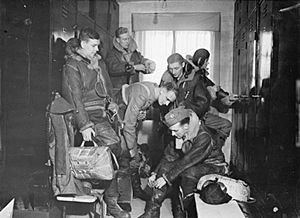
On 14 December 1939, 12 Wellingtons went on a mission to attack German warships. Five of their bombers were lost. The squadron was part of RAF Bomber Command. They bombed targets in Norway and Germany, mostly at night. In March 1941, they moved to RAF Waterbeach.
In February 1942, the squadron moved to India with their Wellingtons. They started flying missions against Japanese bases in Burma in November 1942. From September 1944, they used Consolidated Liberator planes. These allowed them to reach targets in Thailand and Malaya. Many Royal Australian Air Force and Royal Canadian Air Force aircrew joined the squadron during this time. The squadron was officially closed down on 15 November 1945.
After the Wars: Transport Role
The squadron started up again on 17 November 1945. This time, they became a transport squadron. They used Avro York planes. They helped in the Berlin Airlift, which delivered supplies to West Berlin.
From 1949 to 1959, they flew Handley Page Hastings planes. These were transport aircraft. In 1956, they used them to drop paratroopers during the Suez crisis.
From 1959, the squadron flew the Bristol Britannia. They used these long-range planes to help people in trouble spots around the world. This included places like Congo in 1960 and Aden in 1967. The squadron was closed down again on 6 January 1976.
Modern Era: C-17 Globemaster III
The squadron was reformed in November 2000. This was to operate the RAF's new C-17 aircraft. The first C-17 arrived at Brize Norton on 23 May 2001. One of their first big missions was moving Lynx helicopters to Macedonia. This was for a NATO peacekeeping force.
The C-17 has been very useful for the RAF. In 2009, the UK decided to buy a seventh aircraft. They bought an eighth C-17 in 2012.
In 2013, two No. 99 Squadron C-17s helped transport French military equipment to Mali. On 15 November 2013, a C-17 flew to the Philippines to help with aid after Typhoon Haiyan.
In August 2021, the C-17s helped with Operation Pitting. This was to evacuate people from Kabul. Four aircraft were used, and they carried more people than usual. On one flight, 436 people were on board. This was the most people ever flown on a single RAF aircraft.
On 13 September 2022, a C-17 from No. 99 Squadron carried the coffin of Queen Elizabeth II. It flew from Edinburgh Airport to RAF Northolt for her state funeral.
Aircraft Used by No. 99 Squadron
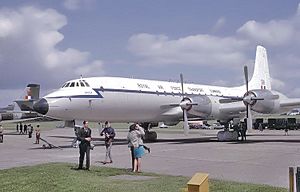
| From | To | Aircraft | Variant | Notes |
|---|---|---|---|---|
| March 1918 | November 1918 | de Havilland DH.9 | Single-engine biplane bomber | |
| August 1918 | March 1920 | de Havilland DH.9A | Single-engine biplane bomber | |
| April 1924 | December 1924 | Vickers Vimy | Twin-engine biplane bomber | |
| August 1924 | December 1925 | Avro Aldershot | Mk.III | Single-engine heavy bomber |
| December 1925 | January 1931 | Handley Page Hyderabad | Twin-engine biplane heavy bomber | |
| October 1929 | December 1933 | Handley Page Hinaidi | Twin-engine biplane heavy bomber | |
| November 1933 | September 1937 | Handley Page Heyford | Mk.I | Twin-engine biplane heavy bomber |
| November 1934 | August 1938 | Handley Page Heyford | Mk.II | Twin-engine biplane heavy bomber |
| December 1935 | November 1938 | Handley Page Heyford | Mk.III | Twin-engine biplane heavy bomber |
| October 1938 | December 1939 | Vickers Wellington | Mk.I | Twin-engine medium bomber |
| September 1939 | April 1940 | Vickers Wellington | Mk.Ia | Twin-engine medium bomber |
| March 1940 | February 1942 | Vickers Wellington | Mk.Ic | Twin-engine medium bomber |
| July 1941 | October 1941 | Vickers Wellington | Mk.II | Twin-engine medium bomber |
| October 1942 | May 1943 | Vickers Wellington | Mk.Ic | Twin-engine medium bomber |
| April 1943 | August 1944 | Vickers Wellington | Mk.III | Twin-engine medium bomber |
| April 1943 | August 1944 | Vickers Wellington | Mk.X | Twin-engine medium bomber |
| September 1944 | November 1945 | Consolidated Liberator | Mk.VI | Four-engine heavy bomber |
| November 1947 | September 1949 | Avro York | C.1 | Four-engine transport |
| August 1949 | June 1959 | Handley Page Hastings | C.1 | Four-engine transport |
| May 1952 | June 1959 | Handley Page Hastings | C.2 | Four-engine transport |
| June 1959 | January 1976 | Bristol Britannia | C.1 and C.2 | Four-engine transport |
| 2002 | Present Day | Boeing Globemaster | C-17A | Four-engine strategic transport |
Bases of No. 99 Squadron
| From | To | Base | Remark |
|---|---|---|---|
| 15 August 1917 | 30 August 1917 | RAF Yatesbury, Wiltshire | First time the squadron was formed |
| 30 August 1917 | 25 April 1918 | RAF Ford Farm, Wiltshire | |
| 25 April 1918 | 3 May 1918 | St. Omer, France | |
| 3 May 1918 | 5 June 1918 | Tantonville, France | |
| 5 June 1918 | 16 November 1918 | Azelot, France | |
| 16 November 1918 | 29 November 1918 | Auxi-le-Chateau, France | |
| 29 November 1918 | 12 December 1918 | St. André-aux-Bois, France | |
| 12 December 1918 | 1 May 1919 | Aulnoye, France | |
| 1 May 1919 | 15 June 1919 | en route to British India | By ship |
| 15 June 1919 | 30 September 1919 | Ambala, Haryana, British India | |
| 30 September 1919 | 2 April 1920 | Mianwali, Punjab, British India | Also had a small group at Kohat |
| 1 April 1924 | 31 May 1924 | RAF Netheravon, Wiltshire | Squadron formed for the second time |
| 31 May 1924 | 5 January 1928 | RAF Bircham Newton, Norfolk | |
| 5 January 1928 | 15 November 1934 | RAF Upper Heyford, Oxfordshire | |
| 15 November 1934 | 2 September 1939 | RAF Mildenhall, Suffolk | |
| 2 September 1939 | 8 March 1941 | RAF Newmarket, Suffolk | Temporarily at RAF Lossiemouth and Salon, France |
| 8 March 1941 | 12 February 1942 | RAF Waterbeach, Cambridgeshire | |
| 12 February 1942 | 1 June 1942 | en route to British India | |
| 1 June 1942 | 12 September 1942 | Ambala, Haryana, British India | Squadron re-formed here. Also had small groups at Solan and Pandaveswar |
| 12 September 1942 | 24 October 1942 | Pandaveswar, Bengal, British India | |
| 24 October 1942 | 3 April 1943 | Digri, Bengal, British India | |
| 3 April 1943 | 14 June 1943 | Chaklala, Punjab, British India | |
| 14 June 1943 | 27 August 1944 | Jessore, Bengal, British India | Also had small groups at Argatala and Kumbhirgram |
| 27 August 1944 | 1 August 1945 | RAF Dhubalia, Bengal, British India | |
| 1 August 1945 | 15 November 1945 | RAF Cocos Islands, Straits Settlements | |
| 17 November 1947 | 16 June 1970 | RAF Lyneham, Wiltshire | Squadron formed for the third time. Temporarily at RAF Wunstorf, Germany |
| 16 June 1970 | 7 January 1976 | RAF Brize Norton, Oxfordshire | |
| 1 January 2002 | present | RAF Brize Norton, Oxfordshire | Squadron formed for the fourth time |
See also
- List of Royal Air Force aircraft squadrons




